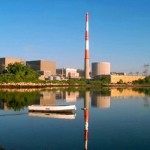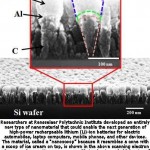
According to the Project Design Document (PDD) available at UNFCCC website, the purpose of the project activity is to recover heat from the exhaust flue gases of two ‘Process Gas Compressors’, (used for compressing the associated gas in crude oil production activities), installed at ONGC’s offshore Mumbai South Platform (MSP). The MSP is a new platform and the waste heat recovery system is installed with the process gas compressor.
ONGC has installed Waste Heat Recovery Units (WHRU) at each of the PGC exhaust points, and the waste heat is being used to heat process oil which is further used to heat various process streams in the crude oil production activities. The project activity has resulted in reducing the consumption of fossil fuels (natural gas), which would otherwise be used for heating of process oil for crude oil production activities.
Project Description
The WHRU is designed to extract heat from exhaust flue gases of process gas compressors and heat the well fluid and glycol reboiler in the glycol regeneration system. In the project activity, the exhaust flue gases from PGC, which are at a very high temperature (approximately 450-500 Degree Celsius), is brought into contact with circulating process oil through a WHRU. The waste heat of exhaust flue gases of PGC is gained by the process oil, which is being circulated from discharge of hot oil pump to the WHRU, through heat transfer. The hot process oil is then circulated through two glycol re-boilers in the glycol regeneration system to heat glycol solution.
Project’s Contribution to Sustainable Development
The project has contributed to sustainable development in several ways by reducing fossil fuel consumption for oil production activities. The indicators for sustainable development as stipulated by Designated National Authority (DNA) of India in the interim approval guidelines for Indian CDM projects have been studied in the context of project activity to ensure that project activity contributes to the sustainable development.
Social Well Being
The project activity has created direct and indirect employment opportunities for skilled/semi-skilled manpower, during the construction and operational phase of the project. Indirect employment has been generated for the equipment supplier, contractors & technical consultants. The project activity has also resulted in providing better Occupational Health and Safety (OH&S) conditions at the work place.
Economic Well Being
The project activity reduces consumption of fossil fuels for the oil production activities, thereby reducing expenditure on production of petroleum products. The project activity helps in reducing the operating costs. The project activity has also created business opportunities for various stakeholders like suppliers, manufacturers, contractors, etc.
Environmental Well Being
The project activity promotes the recovery of waste heat, which otherwise would have been discharged to the atmosphere. This recovered heat is utilized in heating the process oil which is further used to heat various process streams, thereby reducing the consumption of fossil fuels for oil production activities.
Reduction in use of fossil fuels for oil production reduces the net GHG emissions to the atmosphere. The project activity also addresses the problem of depletion of fossil fuels to a certain extent.
Technological Well Being
The project activity has resulted in reducing the fossil fuel consumption for the oil production activities by using waste heat recovery principle. The technology used can also be applied to other similar projects in oil and gas installations in the country, resulting in reductions in the use of fossil fuels for oil production.
Hence, the project activity contributes to sustainable development.
The Clean Development Mechanism (CDM)
The Clean Development Mechanism (CDM), defined in Article 12 of the Protocol, allows a country with an emission-reduction or emission-limitation commitment under the Kyoto Protocol (Annex B Party) to implement an emission-reduction project in developing countries. Such projects can earn saleable Certified Emission Reduction (CER) credits, each equivalent to one tonne of CO2, which can be counted towards meeting Kyoto targets. The mechanism is seen by many as a trail-blazer. It is the first global, environmental investment and credit scheme of its kind, providing standardized emissions offset instrument, CERs.
A CDM project activity might involve, for example, a rural electrification project using solar panels or the installation of more energy-efficient boilers.
The mechanism stimulates sustainable development and emission reductions, while giving industrialized countries some flexibility in how they meet their emission reduction or limitation targets.
CDM Project Activity Outlook
Clean Development Mechanism (CDM) projects have a vast potential for developing countries like India and China. Out of a total of 2129 registered projects, China and India account for 36.97% and 23.39% respectively.

Think Newswire














